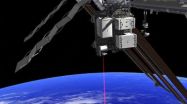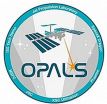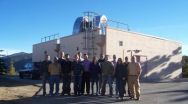(Press-News.org) "Hello, World!" came the message from the International Space Station as NASA successfully beamed high-definition video via laser from space to ground on Thursday, June 5. The 175-megabit video transmission was the first of its kind for the Optical Payload for Lasercomm Science (OPALS) with the goal of improving the way we receive data from orbit and beyond. In fact, this emerging technology of optical communications--or lasercomm--is likened to an upgrade from dial-up to DSL.
"It's incredible to see this magnificent beam of light arriving from our tiny payload on the space station," said Matt Abrahamson, OPALS mission manager at NASA's Jet Propulsion Laboratory (JPL) in Pasadena, California.
OPALS launched to the space station aboard the SpaceX Dragon earlier this spring. This technology demonstration furthers NASA's exploration of higher-bandwidth methods of communicating with future spacecraft. Optical communications tools like OPALS use focused laser energy to achieve data rates 10 to 1,000 times higher than current space communications, which rely on radio portions of the electromagnetic spectrum.
OPALS' success also is an important step in improving communication rates with spacecraft beyond low-Earth orbit. The instrument allows for communications rates to keep pace with the ever-increasing data generation produced by scientific instruments. The capability could replace the Federally-regulated radio frequencies currently in use from orbit to meet the needs anticipated by researchers for future missions, like Mars.
"We look forward to experimenting with OPALS over the coming months in hopes that our findings will lead to optical communications capabilities for future deep space exploration missions," Abrahamson said.
The space station moves through Earth's sky at approximately 17,500 mph. This speed requires extreme precise pointing ability. It's equivalent to a person aiming a laser pointer at the end of a human hair 30 feet away and keeping it there while walking. To achieve this precision, OPALS locked onto a ground beacon emitted by the Optical Communications Telescope Laboratory ground station at the Table Mountain Observatory in Wrightwood, California.
Once locked onto the signal, OPALS began to modulate the beam from its 2.5-Watt 1,550-nanometer laser to transmit the video. The entire transmission lasted 148 seconds and achieved a maximum data rate of 50 megabits per second. It took OPALS 3.5 seconds to transmit a single copy of the "Hello World!" video message, which would have taken more than 10 minutes using traditional downlink methods. The message was sent multiple times during the transmission.
The OPALS instrument was built at JPL as part of the Phaeton hands-on training program and is slated to run for a prime mission of 90 days. The OPALS Project Office is based at JPL, a division of the California Institute of Technology in Pasadena. During these transmissions, NASA also will train personnel in optical communication systems operations, leading to improved optical communication instrument design.
Commercial ventures can likewise take note of the project, as it proves the use of lasercomm for optimized communications from space. This may mean higher definition video feeds from near-Earth assets, such as satellites, as well as those in deep space, like future Mars rovers. This improves the interaction and experience with the stakeholders, whether they be researchers, engineers or consumers. And if you remember the days of having to leave the room to download a video when using DSL, you know that higher-speed downloads are definitely the way to go!
INFORMATION:
'Hello, world!' NASA beams video from space station via laser
2014-06-09
ELSE PRESS RELEASES FROM THIS DATE:
African-American women more likely to be diagnosed with higher risk breast cancer
2014-06-09
Washington, D.C., June 9, 2014 - A research study led by cancer specialists at MedStar Washington Hospital Center found that African-American women frequently present with biologically less favorable subtypes of breast cancer.
Researchers at the Hospital Center's Washington Cancer Institute analyzed the biology of breast cancer in 100 African-American women, using a method of genomic profiling. These genomic tests look at the expression of genes associated with the risk of recurrence in the population and further characterizes the biology of the tumor. The 70-gene MammaPrint ...
Affordable housing linked to children's test scores
2014-06-09
It's long been accepted – with little science to back it up – that people should spend roughly a third of their income on housing. As it turns out, that may be about how much a low-income family should spend to optimize children's brainpower.
Johns Hopkins University researchers have explored the effects of affordable housing on the cognitive development, physical health, and emotional wellbeing of children living in poverty. How much a family spends on housing has no impact on a child's physical or social health, they found, but when it came to cognitive ability, it ...
New study finds text messaging program benefits pregnant women
2014-06-09
WASHINGTON, DC (June 9, 2014) – The leading mobile health service in the nation, Text4baby, was found to significantly benefit pregnant women, according to a new study led by Milken Institute School of Public Health (Milken Institute SPH) at the George Washington University and the Madigan Army Medical Center. The pilot study examined several things including the short-term effects of Text4baby exposure four weeks post enrollment on attitudes, beliefs and behaviors targeted by the text messages.
"This study provides the strongest evidence to date that Text4baby reduces ...
Combined MMRV vaccine shows slight rise in adverse events
2014-06-09
The combined measles–mumps–rubella–varicella (MMRV) vaccine shows a slightly increased risk of febrile seizures in children, compared with the previously separate vaccines for MMR and varicella (chickenpox) (MMR+V), according to an article in CMAJ (Canadian Medical Association Journal).
The MMRV vaccine was developed for young children to reduce the number of needles they receive. However, the combined vaccine has been associated with slightly higher rates of febrile seizures.
Febrile seizures can accompany high fever in young children; although distressing, they are ...
Stem cells are a soft touch for nano-engineered biomaterials
2014-06-09
Scientists from Queen Mary University of London have shown that stem cell behaviour can be modified by manipulating the nanoscale properties of the material they are grown on - improving the potential of regenerative medicine and tissue engineering as a result.
Stem cells are special because they are essential to the normal function of our organs and tissues. Previous research shows stem cells grown on hard substrates go on to multiply but do not differentiate: a process by which the cells specialise to perform specific functions in the body. In contrast, stem cells ...
PET/MR is superior for verifying coronary arterial disease
2014-06-09
St. Louis, Mo. (June 9, 2014) – Ischemic heart disease, a narrowing of the arteries supplying blood to the heart, is a leading cause of death throughout the world. A hybrid molecular imaging technique called positron emission tomography and magnetic resonance (PET/MR) imaging, which tells doctors vital information about cardiac and arterial function, has been found to be an effective molecular imaging tool for detecting coronary artery disease (CAD), say researchers at the Society of Nuclear Medicine and Molecular Imaging's 2014 Annual Meeting.
Often patients suspected ...
Stem cell-stimulating therapy saves heart attack patients
2014-06-09
St. Louis, Mo. (June 9, 2014) – Researchers at the Society of Nuclear Medicine and Molecular Imaging's 2014 Annual Meeting revealed how a protein encourages the production of stem cells that regenerate damaged tissues of the heart following an acute attack (myocardial infarction). They further assert that it has a better chance of working if provided early in treatment. This was confirmed by molecular imaging, which captured patients' improved heart health after therapy.
If given after a heart attack, granulocyte colony-stimulating factor (G-CSF) mobilizes bone marrow ...
SPECT/CT reveals best treatment for low back pain
2014-06-09
St. Louis, Mo. (June 9, 2014) – Low back pain is not only excruciating but also debilitating for countless sufferers. Unfortunately, not everyone responds to treatment. A molecular imaging scan in addition to a conventional bone scan can provide the necessary information about the physiological health of the spine to select the most appropriate pain-killing treatment protocol, say researchers at the Society of Nuclear Medicine and Molecular Imaging's 2014 Annual Meeting.
Conventional imaging methods including X-ray, computed tomography and even magnetic resonance imaging ...
Chemo-radionuclide therapy halts neuroendocrine cancer
2014-06-09
St. Louis, Mo. (June 9, 2014) – Advanced cancer of the neuroendocrine system can lead to dismal prognoses, but a novel therapy is packing a punch by uniting powerful radionuclide treatment and chemotherapy drugs, revealed researchers at the Society of Nuclear Medicine and Molecular Imaging's 2014 Annual Meeting.
The research findings show that the experimental therapy led to stabilization or regression of patients' cancer in about 70 percent of cases a year after completion of the treatment, now called peptide receptor chemo-radionuclide therapy (PRCRT). The therapy is ...
Opti-SPECT/PET/CT: 5 different imaging systems now combined
2014-06-09
St. Louis, Mo. (June 9, 2014) – Taking their pick, biomedical researchers can now conduct five different imaging studies in one scan with a state-of-the-art preclinical molecular imaging system that scientists unveiled during the Society of Nuclear Medicine and Molecular Imaging's 2014 Annual Meeting.
The imaging device allows single photon emission tomography (SPECT), positron emission tomography (PET), X-ray computed tomography, fluorescence and bioluminescence imaging—powerful imaging techniques that provide different information about anatomy and physiological processes ...



